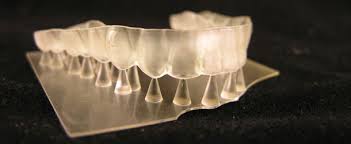Paving The Way To A Brighter Smile - 3D Printing Innovations In Dental Tech
Our teeth are something we use day in and day out without much thought, that is until something goes wrong and we’re forced to begrudgingly go to the local dentist and wait to be seen. But why are we so anti-dentist? It’s simple - time, cost and pain.
With as many technological advancements being made to make our lives easier and more consumable, most people would be surprised to hear that one area taking a lot of shape and seeing tons of innovation is dentistry. There are an overwhelming amount of inventions such as the Implantpilot and CAD/CAM but the issue is the everyman doesn’t know about these advancements trying to solve their problems. One solution that needs to be put higher on their radar is 3D printing.

For one, 3D printing is a valuable and effective tool for producing precise and accurate models, moulds and casts of teeth. It saves over 50 percent of a technician’s time in designing and manufacturing restorations. Traditionally, when undergoing a restorative dental procedure you have to schedule multiple appointments. The first is where the dentist makes a mould of your tooth. After spending an hour or so waiting to be seen, you’re injected with a numbing solution, spend some more time waiting for it to take effect, and then the dentist comes back in with impression materials that come in a tray and take time to set. Once that’s complete, your mould is sent off to a lab and weeks later, you are summoned back to the office with the actual cast ready to be installed.

3D printing bypases all this back and forth. With a 3D printer, patients can have their mouth digitally scanned. An image is instantly sent to a computer (no injections or sitting still with a mouthful of setting material) and the dentist can then take a look at the image and manually tweak it to add in another level of precision. Using the software, the dentist can shave off sides and add in indentations to get an exact replica of what your mould should be. After that, the image is sent to the 3D printer that instantly prints out the tooth to be installed within the same day - saving the patient time, money and pain.
An excellent example of the 3D printer being put to good dental use is the Shirley Technique. Recently, Dr. Travis Bellichi, a maxillofacial prosthodontics resident at the IU School of Dentistry, worked with Shirley Anderson, a cancer survivor who lost his jaw due to radiation treatments. Unable to have a prosthetic produced that was comfortable and less invasive to create, Dr. Bellichi turned to 3D printing to solve the problem. Digitally scanning Shirley’s face (avoiding the plaster casting technique), he was able to sculpt a jaw that was more lifelike. With restorative dental moulds that all require a level of customization, 3D printing is a proven valuable asset.

There’s also the added layer of creating moulds and teeth made of antimicrobial plastic that kills bacteria responsible for tooth decay on contact. Dutch researchers are developing a bacteria fighting tooth made with materials that can be embedded within dental resin polymers using a 3D printer. Although this research is still in development, it is an amazing advancement that can be implemented to further the field of dental care.
3D printing is not just for hobbyists or to create amusing toys, it is something that really can change lives in a meaningful way. It’s currently being put into practice in the dental profession from acclaimed orthodontists to a digital design student who was able to manufacture his own clear braces for a rate exponentially lower than brands like Invisalign and ClearCorrect. With so many applications and ways to effectively help people have a newfound appreciation for the dentist, 3D printing is the future and more people should inquire more with their local dentists about it.


Comments
Leave your comment